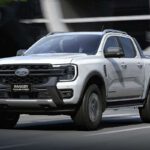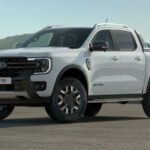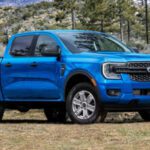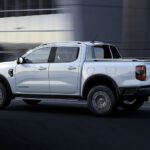2025 Ford Ranger
The 2025 Ford Ranger is a compact or mid-size pickup marketed globally by Ford. The 2025 Ford Ranger is a midsize pickup truck available as an extended cab with a 6-foot bed (SuperCab) or a crew cab with a 6-foot bed (SuperCrew). The 2025 Ford Ranger is available in three trim levels: XL, XLT, and Lariat. All are powered by a turbocharged 2.3-liter four-cylinder engine and mated to a 10-speed automatic transmission that drives the rear or all four wheels.
The Ford Ranger also comes with Ford’s Co-Pilot360 suite of driver-assistance features, which includes blind-spot monitoring, rear parking sensors, and lane-keep assist. 2025 Ford Ranger Technology package, which includes adaptive cruise control, a 360-degree camera system, and front parking sensors. The cabin has undergone a major refresh and now includes a large, vertically-oriented infotainment system similar to the one found as an option on higher-end models of the Edge SUV. The 2024 Ranger will face new rivals like the Chevrolet Colorado, GMC Canyon, and Toyota Tacoma, all of which are ranked highly in recent redesigns.
2025 Ford Ranger : Interior
Inside, the 2025 Ranger’s cabin gets a modern look with an available digital instrument display, textured dashboard trim, and honeycomb-pattern air vents. Many of the truck’s various controls and buttons have been digitized and are now part of the infotainment system. Ford has added a variety of interior storage solutions to the new Ranger’s interior, including a hidden upper glovebox in the dash, larger door pocket compartments, and storage space under the truck’s rear seat. The only body style this time around is the SuperCrew crew cab, which has four full-size doors with seating for five.
A 10.1-inch infotainment screen is standard, but tech-focused buyers can upgrade to an even larger, vertically oriented 12.4-inch screen. Ford’s latest Sync 4 interface works on both and provides access to the Ranger’s various controls. These controls include enabling a new zone lighting feature that turns on the lights on the outside of the truck to provide illumination to illuminate a job site or complete a camping setup. darkness. All models also feature an 8.0- or 12.4-inch digital instrument display. Apple CarPlay and Android Auto are standard, and we expect extra features like in-car navigation, a wireless smartphone charging pad, and SiriusXM satellite radio to be offered as well.
2025 Ford Ranger : Engine
Ford Rangers come with the same turbocharged 2.3-liter four-cylinder engine as the previous model. The engine produces 270 horsepower, which in our experience provides enough power to move a mid-sized truck. It’s expected this to change in the new model comes with a twin-turbocharged 2.7-liter V-6 that comes in higher trims and produces 315 horsepower. Both are mated to a 10-speed automatic transmission and can be had with rear-wheel drive or all-wheel drive. No matter which engine you choose, the Ranger is capable of towing up to 7,500 pounds. With all-wheel drive, the truck’s maximum payload drops from 1805 pounds to 1711 pounds for rear-wheel drive models.
- Ford Ranger 2025 Lightning
- 2025 Ford Ranger Raptor Australia
- 2025 Ford Ranger PHEV
- 2025 Ford Ranger Lariat
- Ford Ranger 2025 Australia
Ford Ranger provides good fuel consumption for the compact pickup truck segment. The rear-wheel-drive models get an EPA-estimated 20 to 21 mpg in the city and 26 mpg on the highway. All-wheel-drive variants get 20/24 mpg in city/highway driving, while models with all-wheel drive and the Tremor off-road package get 19 mpg in both city and highway driving.
2025 Ford Ranger : Safety
The 2025 Ranger comes standard with basic driver-assistance features, but more advanced technology requires stepping up to a higher trim or adding an option package. Fortunately for those who want these systems, the option packages are relatively affordable. Ford Ranger crash tests are available on the websites of the National Highway Traffic Safety Administration (NHTSA) and the Insurance Institute for Highway Safety (IIHS). Key safety features include blind-spot monitoring, automatic emergency braking, adaptive cruise control, rear cross-traffic alert, and forward collision warning.







